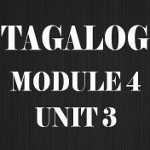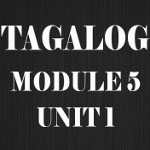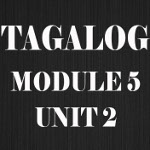OBJECTIVES
At the end of this module, you will be able to perform the following tasks in Pilipino:
- Tell a department store clerk what you’re looking for.
- Say you like a particular item of clothing, ask if you can try it on, and understand the clerk’s answer.
- Ask for an item of clothing by size or color.
- Say why an article of clothing doesn’t fit.
Audio for this lesson
Sa Tindahan ng Damit
At the Clothing Store
| Tindera: | Ano po ang kailangan ninyo, mamà? | What do you need, sir? [Can I help you, sir?] |
| Bob: | Naghahanap ako ng magandang burdadong polo baróng. | I’m looking for a nice embroidered polo baróng. |
| Tindera: | Para sa inyo ba? | Is it for you? |
| Bob: | Hindi, para sa aking kapatid na lalaki sa Amerika. | No, it’s for my brother in America. |
| Tindera: | Anong sukat niya? | What’s his size? |
| Bob: | Midyum, katulad ko. | Medium, like me. |
| Tindera: | Mamili kayo rito. | (You) choose from here. |
| Bob: | Maaari bang isukat ko ang kulay asul? | Can I try on the blue (color) [one]? |
| Tindera: | O0, maaari. | Yes, you can. |
| * * * | ||
| Bob: | Hindi magkasiya ito sa akin. Masikip nang kaunti. | This doesn’t fit me. It’s a little tight. |
| Tindera: | Eto ang malaki-laki. Isukat ninyo. | Here’s one a little larger. Try it on. |
| * * * | ||
| Bob: | Aba, tamang-tama ito! Magkano ito? | Ah, this is just right! How much is this? |
| Tindera: | Nobentay sais pesos. | Ninety-six pesos. |
NOTES ON THE CONVERSATION
Polo baróng is a short-sleeved version of the traditional barong Tagalog. The barong Tagalog is a long-sleeved, usually embroidered dress shirt worn on formal occasions; traditionally it is white, although some are now also available in pastel colors. These shirts are worn over pants and without a tie.
Burdadong is burdado (“embroidered”) plus -ng linker.
Isukat ko means “tryon by me.” Maaari bang isukat ko ang kulay asul? literally is “Can the blue color be tried on by me?”
EXERCISES
Exercise 1. Repetition
| Polo baróng | embroidered short-sleeved shirt |
| barong Tagalog | lightweight, embroidered longsleeved shirt |
| kamisatsino | collarless Chinese shirt |
| kamiseta | undershirt or T-shirt |
| sando | sleeveless undershirt |
| kamisadentro | shirt with a collar |
| kamisadentrong mahabang manggas | long-sleeved shirt |
| kamisadentrong maikling manggas | short-sleeved shirt |
| kurbata | necktie |
| amerikana | suit |
| pantalon | pants |
| sapatos | shoes |
| kalsunsilyo | underwear |
| sombrero | hat |
| medyas | socks |
| tsinelas | slippers |
Exercise 2.
| You hear: | Ano po ang kailangan ninyo? | ||||||||||
| You see: | T-shirt | ||||||||||
| Say: | Naghahanap ako ng kamiseta. | ||||||||||
|
|||||||||||
Exercise 3. Repetition
| barò OR bestido | dress |
| kamison | chemise or slip |
| medyas | stockings or socks |
| palda | skirt |
| saya | long skirt |
| sapatilya | step-in evening shoes |
| blusa | blouse |
| bakyà | wooden shoes |
| panyolito | handkerchief |
| bandana | scarf |
| terno | traditional butterfly-sleeved dress |
| pansut | pantsuit |
| payong | umbrella |
Exercise 4. Repetition
| para sa akin | for me |
| para sa aking anak | for my child |
| para sa aking maybahay | for my wife |
| para sa aking kaibigan | for my friend |
| para sa aking anak na lalaki | for my son |
| para sa aking anak na babae | for my daughter |
| para sa aking nobya | for my girl friend |
| para sa aking nanay | for my mother |
| para sa aking tatay | for my father |
Exercise 5. Say in Pilipino:
- I’m looking for a blouse for my wife.
- I’m looking for a shirt for my father.
- I’m looking for shoes for my daughter.
- I need pants for my son.
- I’m looking for a necktie for my husband.
- I need a barong Tagalog.
- Do you have a long skirt?
Exercise 6. Repetition
| puti | white |
| itim | black |
| itim na itim | jet black |
| dilaw | yellow |
| dilaw na dilaw | deep yellow |
| dilaw na mura | light yellow |
| asul | blue |
| asul na asul | dark blue |
| asul na mura | light blue |
| berde | green |
| berdeng-berde | dark green |
| berdeng mura | light green |
| pula | red |
| pulang-pula | dark red |
| granate | garnet color |
| kulay kape | brown, “color of coffee” |
| kulay ubi | purple, “color of purple yam” |
| kulay abo | gray, “color of ash” |
| kulay balat | tan, “color of skin” |
| kulay rosas | pink, “color of rose” |
| kulay orens | orange, “color of orange” |
| is used after words ending in a vowel. Ex: blusa (blouse) blusang asul (blue blouse) |
|
| is used after words ending in a consonant, except “n”. Ex: medyas (socks) medyas na itim (black socks) |
|
| is used after words ending in “n”. Ex: kamison (slip) kamisong puti (white slip) |
Exercise 7. Repetition
Gusto ko ang berde.
I’d like the green.
Gusto ko ang dilaw.
I’d like the yellow.
Gusto ko ang sapatos na pula.
I’d like the red shoes.
Gusto ko ang blusang asul pero midyum.
I’d like the blue blouse but medium.
Gusto ko ang pantalong itim pero sukat treyntay
I’d like the black pants, but size 34.
Gusto ko ang malaking polo barong na puti.
I’d like the large white polo barong.
Gusto ko ang barong kulay balat pero sukat otso.
I’d like the tan dress, but size 8.
Exercise 8.
| You hear: | kamison – itim | |||||||||
| Say: | Gusto ko ang kamisong itim. | |||||||||
|
||||||||||
Exercise 9.
| You hear: | puti – sapatos | |||||||||||
| Say: | Kailangan ko ng puting sapatos. | |||||||||||
|
||||||||||||
Exercise 10.
| Gusto ko ito. | I like this. |
| Gusto ko ang mga ito. | I like these. |
| Gusto ko ito. | I like this. |
| Gusto ko ang mga ito. | I like these. |
| You hear: | blusa | ||||||||||
| Say: | Gusto ko ito. | ||||||||||
| OR | |||||||||||
| You hear: | mga blusa | ||||||||||
| Say: | Gusto ko ang mga ito. | ||||||||||
|
|||||||||||
Exercise 11. Repetition
| Gusto ko iyan. I like that. |
Gusto ko ang dilaw na iyan. I like that yellow [one]. |
| Gusto ko ang mga iyan. I like those. |
Gusto ko ang mga dilaw na iyan. I like those yellow [ones]. |
Gusto ko ang pulang iyan.
I like that red one.
Maaari bang isukat ko ang puting iyan?
May I try on that white one?
Gusto ko ang berdeng iyan – sukat treyntay dos.
I would like that green one – size 32.
Ayoko ng mga itim na iyan.
I don’t like those black ones.
Gusto kong isukat ang mga kulay kape.
I would like to try on those brown ones.
Exercise 12. Say in Pilipino:
| ito (this) Gusto ko ito. |
ang mga… ito (these) Gusto ko ang mga ito. |
| iyan (that) Gusto ko ang blusang iyan. |
ang mga… iyan (those) Gusto ko ang mga blusang iyan. |
| iyon (that over there) Gusto ko ang berdeng iyon. |
ang mga… iyon (those over there) Gusto ko ang mga berdeng iyon. |
- I like this one.
- I don’t like those.
- I like those over there.
- Can I try that shirt on?
- I’m looking for a tan tie.
- Can I tryon these dresses?
- I would like to try those on.
- I would like to try on that blue blouse over there.
- I need a shirt for my son – size 14.
Exercise 13. Repetition
| malaki | large or big |
| malaki nang kaunti | a little large |
| masyadong malaki | very large, too large |
| maliit | small |
| maliit nang kaunti | a little small |
| masyadong maliit | very small, too small |
| mahaba | long |
| mahaba nang kaunti | a little long |
| masyadong mahaba | very long, too long |
| maikli | short |
| maikli nang kaunti | a little short |
| masyadong maikli | very short, too short |
| kasiya | fits, fitting |
| kasiyang-kasiya | fits well, well-fitting |
| hindi kasiya | doesn’t fit |
| husto | all right |
| hustung-husto | just right |
| tama | OK |
| tamang-tama | perfect |
Exercise 14. Say in English:
- large
- small
- long
- short
- very short
- fits
- all right
- OK
- perfect
- very long
- a little small
- fits well
Exercise 15.
| You hear: | too long | ||||||
| Say: | Hindi magkasiya ito sa akin, masyadong mahaba. | ||||||
|
|||||||
Exercise 16. Say in English:
- Anong sukat mo?
- Mamili kayo rito.
- Eto ang malaki-laki.
- Isukat ninyo.
- Para sa asawa mo ba?
- Anong sukat ang kailangan ninyo?
- Maliit ba nang kaunti?
- Heto ang kulay pula.
- Isukat ninyo ang blusa na sukat 14.
- Gusto ba ninyo ang amerikanang asul?
Exercise 17. Conversation for Listening Comprehension
| Tindera: | Hoy, Anne, anong kailangan mo ngayon? |
| Anne: | Isang pansut. |
| Tindera: | Para sa iyo ba? |
| Anne: | Oo, para sa akin. |
| Tindera: | Anong sukat mo? |
| Anne: | Dose. |
| Tindera: | Gusto mo ba ng mga itim? Mayroon ding granate. Mamili ka. |
| Anne: | Gusto ko sana ang granateng ito. |
| Tindera: | Isukat mo. |
| Anne: | Maganda ito pero maiikli nang kaunti. Maaari bang isukat ko ang itim na iyan? |
| Tindera: | Sige. Isukat mo. |
| Tindera: | Ano, tama ba? |
| Anne: | Hustung-husto ito. Magkano ba? |
| Tindera: | Sitentay singko pesos lamang. |



